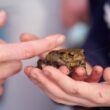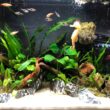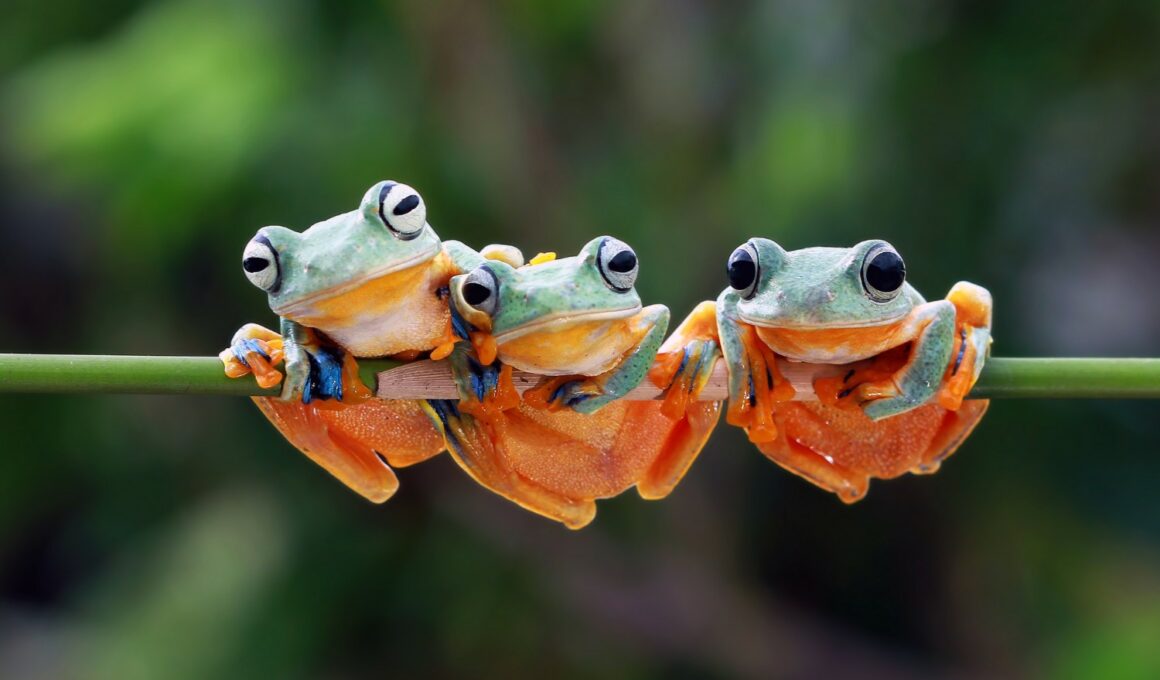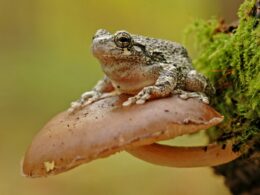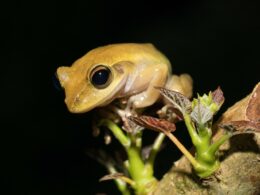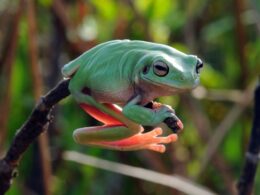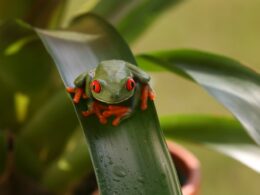In this article Show
Tree frogs are little creatures that have probably piqued your interest once or twice. They’re not just the colorful critters sticking to your windowpanes on rainy nights.
Tree frogs play a pivotal role in our ecosystems, keeping insect populations in check and serving as a vital link in the food chain.
Diving into the world of tree frogs can be an exhilarating experience. From the dense canopies of tropical rainforests to the cool, shaded understory of temperate forests, and even the watery realms of wetlands, tree frogs have made their mark in a diverse range of habitats.
In this comprehensive guide, we’ll explore the habitats they thrive in, their distinct physical attributes, the intriguing menu that makes up their diet, and the amazing adaptations that help them survive in the wild. Beyond that, we’ll touch upon their predators, and sadly, the mounting threats they face in today’s changing world.
Tree Frog Habitat
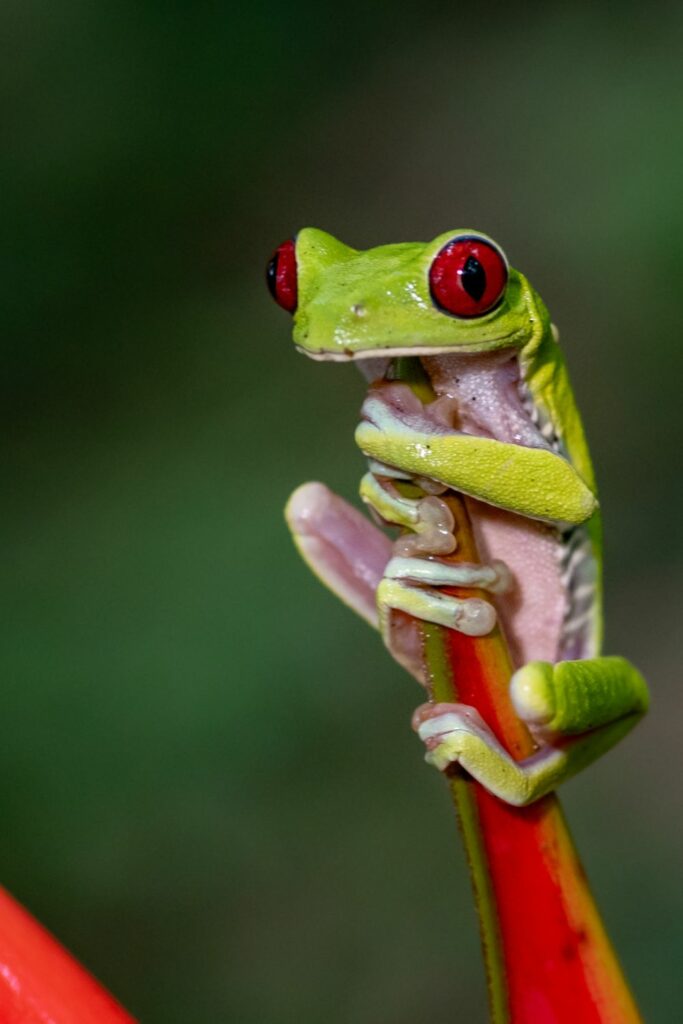
When you think of where tree frogs might be hanging out (or hanging on!), diverse habitats across the globe might come to mind.
From the luscious greens of rainforests to the mellow ambiance of temperate woods and the marshy grounds of wetlands, tree frogs have truly diversified their living quarters. Let’s jump right in and explore these habitats in detail.
Tropical Rainforests
Importance of Tropical Rainforests to Tree Frogs
Tropical rainforests are a haven for tree frogs. The consistent warmth, ample rainfall, and the buffet of insects make it an ideal habitat. Moreover, the multilayered structure of the rainforest, from canopy to forest floor, offers various microhabitats suitable for different species of tree frogs.
Distribution of Tree Frogs in Tropical Rainforests
Sprawling from Central and South America to parts of Asia and Africa, tropical rainforests house a majority of the world’s tree frog species. Regions like the Amazon Basin and Borneo are teeming with a kaleidoscope of these amphibians, each with its distinct call and color.
Special Characteristics of Tree Frogs in This Habitat
Tropical tree frogs are a marvel. Many have developed vibrant colors, which often serve as warnings to predators or as camouflage. Additionally, their nocturnal habits help them avoid the scorching sun and predators while capitalizing on the night’s insect bounty.
Temperate Forests
Distribution in Temperate Zones
Venturing away from the equator, tree frogs can be found in temperate forests across North America, parts of Europe, and Asia. Think of places with distinct seasons – yes, some tree frogs have adapted to cope with colder climates!
Differences Between Tropical and Temperate Tree Frogs
It’s not just the temperature range that sets these two groups apart. While tropical tree frogs tend to be smaller and more vibrantly colored, their temperate cousins often exhibit subdued hues, blending in with the fallen leaves and bark.
Their metabolism and hibernation patterns also differ, with many temperate tree frogs going into a kind of winter dormancy to survive the colder months.
Wetlands
Importance of Wetlands to Tree Frog Populations
Wetlands, with their stagnant or slow-moving waters, are crucial breeding grounds for many tree frog species. The presence of ample vegetation offers shelter, while the water bodies provide a haven for laying eggs and tadpole development.
Wetland Conservation And Its Impact on Tree Frogs
However, wetlands worldwide are facing threats from drainage for agriculture, urban development, and pollution. As these habitats shrink or degrade, tree frog populations are directly impacted.
Conservation of wetlands doesn’t just mean safeguarding these habitats for frogs, but also ensuring a balanced ecosystem that benefits many other species and maintains water quality for surrounding communities.
Physical Characteristics
Tree frogs, with their petite frames and captivating appearances, have long been subjects of admiration and curiosity. But behind every hue, spot, and warty texture lies a tale of evolution, adaptation, and survival. Let’s delve deeper into the physical traits of these mesmerizing amphibians.
Size
Typical Size Range For Tree Frogs
While the term “tree frog” might conjure images of a small, nimble creature, the truth is that the size of these frogs can vary widely. Most tree frogs are indeed small, with many species measuring between 1 to 5 inches in length. However, outliers do exist; some species, like the White-lipped tree frog from Australia, can grow up to a whopping 5.5 inches!
Factors Affecting Size
Several factors play into the size of a tree frog. Genetics, of course, is the primary driver, dictating the potential size a frog can reach. However, environmental factors, like the availability of food during the tadpole stage and competition from other frogs, can also influence their growth.
Coloration
The Variety of Colors in Tree Frogs
Tree frogs are nature’s artists, donning a range of colors from serene greens and blues to startling yellows and reds. Regions with higher biodiversity, like the Amazon rainforest, often boast tree frogs with incredibly vibrant patterns and hues.
Role of Coloration in Survival
While their colors are undeniably beautiful, they are not just for show. Bright colors can act as a warning signal, indicating toxicity or unpalatability to potential predators.
This is known as aposematism. On the other hand, muted colors, like greens and browns, help tree frogs camouflage against leaves and bark, allowing them to hide from both predators and prey.
Skin Texture
Description and Function
When you look closely, tree frogs often have a slightly bumpy or granular skin texture. Unlike the smooth skin of many other frogs, this textured surface aids them in their arboreal lifestyle.
Role in Moisture Retention and Other Benefits
The skin of a tree frog isn’t just for looks—it plays a pivotal role in their survival. Their semi-permeable skin aids in respiration and moisture absorption. In dry conditions, the textured surface can trap a thin layer of water, reducing evaporation and helping the frog stay hydrated.
This ability to retain moisture is particularly crucial for species inhabiting regions with fluctuating humidity levels.
From their vibrant colors to their moisture-retentive skin, every aspect of a tree frog’s physicality tells a story of adaptation and survival. These characteristics are more than just aesthetics; they are a testament to millions of years of evolution, fine-tuning these frogs for life in their specific niches.
Diet of Tree Frog
One of the delightful aspects of observing tree frogs in their natural habitat is watching them eat. Their hunting techniques, choice of prey, and dietary habits are a marvel of evolution. But what exactly do these agile amphibians munch on?
Insects
Importance of Insects in The Diet
Insects form the bulk of a tree frog’s diet. These readily available, protein-packed morsels are essential for their growth, reproduction, and overall health. The dynamic world of insects provides tree frogs with a variety of options to satisfy their hunger.
Common Insects Consumed
From the slow-moving caterpillar to the elusive flying moth, tree frogs aren’t very picky. They’ll feast on beetles, ants, mosquitoes, and even larger prey like grasshoppers and crickets. Their large, sticky tongues can snap up these insects in a fraction of a second, making them efficient hunters.
Spiders
Role of Spiders in The Diet
While insects are staples, spiders often feature occasional treats in a tree frog’s diet. These eight-legged creatures provide a different nutrient profile and can be particularly beneficial for tree frogs.
Benefits of Consuming Spiders
Spiders, being higher up the food chain than most insects, often contain accumulated nutrients. By eating spiders, tree frogs can obtain a concentrated dose of vitamins, minerals, and other essential compounds.
Additionally, the act of hunting spiders can hone a tree frog’s hunting skills due to the spider’s unpredictable movements.
Small Invertebrates
Examples and Importance
Tree frogs’ diet isn’t limited to just insects and spiders. They also relish other invertebrates like worms, centipedes, and even smaller crustaceans if they come across them. These invertebrates provide variety and ensure that tree frogs get a balanced diet.
Adaptations for Capturing Invertebrates
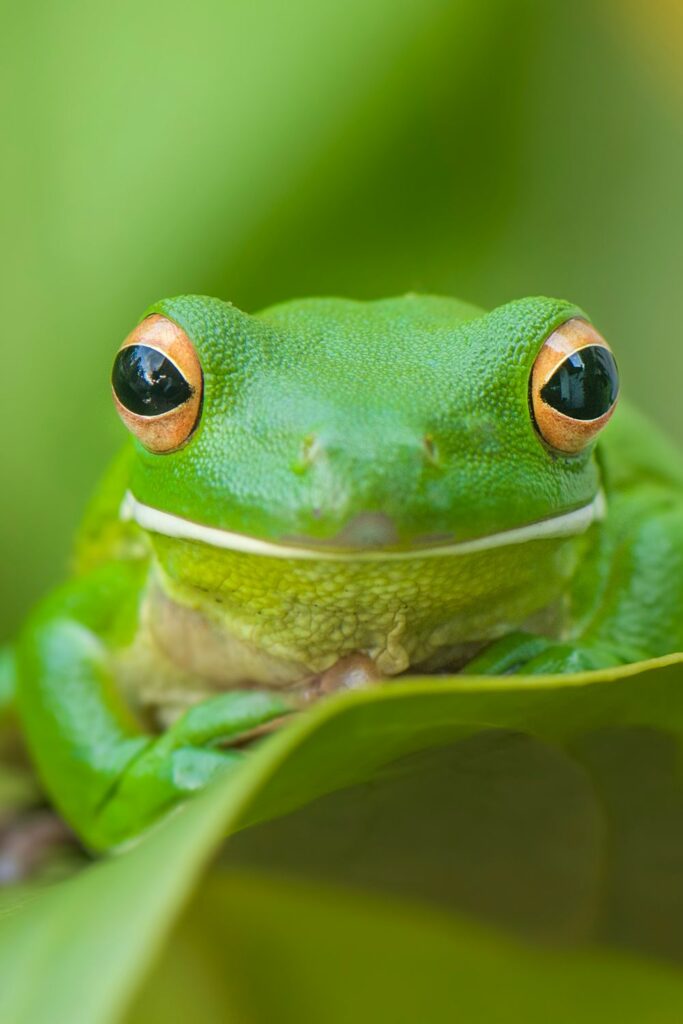
To snag such diverse prey, tree frogs have evolved some remarkable hunting adaptations. Their large, forward-facing eyes give them excellent binocular vision, helping them judge distances accurately.
Their sticky tongues can extend rapidly, snatching up prey before they even realize the danger. Additionally, their agile limbs and toe pads allow them to maneuver swiftly across different terrains, be it leaves, branches, or water surfaces.
The diverse diet of tree frogs paints a picture of their adaptability and resourcefulness. Every meal is a dance of precision, timing, and skill. As they keep insect populations in check, they reaffirm their crucial role in maintaining the ecological balance of their habitats.
Reproduction in Tree Frogs
The life cycle of a tree frog is a captivating journey that commences with a delicate egg and culminates in a nimble adult. Each phase is a dance with nature, relying on environmental cues, behavioral instincts, and a bit of luck. Let’s hop into the world of tree frog reproduction and explore this incredible process.
Breeding Season
Timing and Environmental Cues
The breeding season for tree frogs generally coincides with the onset of rainy seasons or warmer temperatures. This ensures ample water sources for their aquatic offspring. Environmental cues, like increasing humidity, consistent rainfall, and even lunar cycles in some species, trigger the frogs’ reproductive instincts.
Mating Behavior
Unique Mating Calls and Displays
To attract a mate, male tree frogs employ a range of vocal serenades, each species boasting its unique call. These calls not only attract females but also serve as a warning to other males to stake out territory.
Some species even have vocal sacs that inflate like balloons, amplifying their calls. Alongside their vocal efforts, certain tree frogs also engage in displays using their brightly colored limbs or throats to woo potential partners.
Egg Laying
Egg Placement and Protection Strategies
Once a suitable mate is found, the female lays her eggs, often in calm waters or damp, hidden locations to shield them from predators and the elements. The number of eggs can range from a few dozen to several hundred, depending on the species.
Some tree frogs, in a bid to ensure the survival of their offspring, have evolved unique strategies like laying eggs in water-filled tree hollows or even on the backs of the male frogs.
Tadpole Development
The Transition From Egg to Froglet
The journey from egg to froglet is nothing short of miraculous. Upon hatching, the tiny tadpoles are aquatic, possessing gills to breathe underwater and a tail for swimming. As days turn into weeks, they undergo a remarkable transformation called metamorphosis.
Their tails recede, limbs sprout, lungs develop for breathing air, and they start resembling miniature versions of adult frogs. Once this transformation is complete, the young frogs, now termed froglets, are ready to begin their terrestrial lives.
The reproductive cycle of tree frogs is a testament to the marvels of nature. Each stage, from the chorus of mating calls to the delicate dance of metamorphosis, showcases the intricate balance of biology, behavior, and environment.
Observing this cycle brings us closer to understanding the delicate web of life and the vital role that even the smallest creatures play within it.
Adaptation Features of Tree Frogs
Nature, in all its grandeur, has gifted creatures with tools and traits to help them survive and thrive. Tree frogs are no exception. Over millennia, they’ve evolved a set of fascinating adaptations that aid them in their unique arboreal lifestyles, ensuring they remain a step ahead of their challenges. Let’s explore some of these awe-inspiring features.
Toe Pads
Function and Importance
Have you ever wondered how tree frogs can effortlessly cling to slippery leaves, smooth glass, or even hang upside down from branches? The secret lies in their toes! At the tip of each toe is a specialized pad, which is slightly sticky and packed with tiny hexagonal patterns.
These patterns increase surface area, allowing the frog to create a mini-suction effect. Combined with a mucous secretion, these toe pads can grip onto a variety of surfaces, making tree frogs expert climbers.
Camouflage
Role in Protection and Hunting
In the wild, blending in can mean the difference between life and death. Camouflage, a tree frog’s art of disguise, plays a dual role. By mimicking their surroundings, whether it’s the green of leaves or the brown of tree bark, tree frogs can evade keen-eyed predators.
This same stealth also aids them in hunting, allowing them to remain undetected as they lie in wait for an unsuspecting insect to come within reach.
Vocalizations
Variety and Purpose of Calls
If you’ve ever spent a night near a pond or forest, the chorus of frog calls is unmistakable. These vocalizations, far from random croaks, serve specific purposes.
Males primarily use them to attract females during the breeding season. Each species has its unique call, ensuring females find the right mate. But that’s not all.
These calls can also be used to stake out territory, warn of predators, or even communicate environmental changes. The strength, pitch, and frequency of each call can convey different messages, making tree frog vocalizations a complex and vital adaptation.
From sticky toes to melodious calls, tree frogs are a testament to nature’s ability to innovate. These adaptations, honed over countless generations, not only help tree frogs survive in their environments but also showcase the intricate web of relationships and challenges within their ecosystems.
Predators Of Tree Frog
In the intricate web of the ecosystem, tree frogs, while being hunters themselves, are often on the menu for various other creatures. These predators, equipped with their own set of adaptations, pose significant threats to tree frogs.
Let’s delve into the world of tree frog predators and uncover the challenges these amphibians face daily.
Snakes
Types of Snakes and Their Hunting Techniques
Snakes are among the top natural predators of tree frogs. Ranging from stealthy arboreal snakes, like vine snakes, to ground-dwelling species such as the pit vipers, they’ve evolved various hunting techniques.
While some snakes use their keen sense of smell and heat-detecting pits to locate frogs, others rely on their impeccable camouflage to lie in wait and ambush unsuspecting tree frogs. The swift and silent nature of these reptiles makes them formidable foes.
Birds
Bird Species That Prey on Tree Frogs
The skies aren’t always friendly for tree frogs. Birds, with their sharp eyesight and rapid reflexes, are adept at plucking tree frogs from their perches. Species like kingfishers, herons, and various birds of prey have been known to feast on these amphibians.
The agile flycatchers might swoop down on a frog from a branch, while a patient egret might snatch one up from the water’s edge during the frog’s nocturnal hunt.
Mammals
Threats and Defense Mechanisms
Mammals, particularly those of the nocturnal kind, often find tree frogs to be a tasty treat. Creatures such as raccoons, opossums, and even some species of bats might prey on tree frogs.
These mammals use their keen senses of smell and hearing to locate and catch the frogs. To defend against such a diverse array of predators, tree frogs have developed several defense mechanisms.
Camouflage, as mentioned earlier, is their primary mode of defense. Some species have also developed toxins that make them unpalatable or even harmful if ingested.
The bright colors of these toxic frogs act as a warning sign to potential predators. Others might rely on their agility, making swift leaps to escape when threatened.
Threats and Conservation
Tree frogs, like many species on our planet, face a myriad of challenges, many of which are exacerbated or directly caused by human activities. While they have natural predators, as discussed, the threats imposed by human-induced changes are arguably more dire.
Let’s delve into these challenges and also shine a light on the commendable conservation efforts that aim to protect these incredible creatures.
Habitat Loss
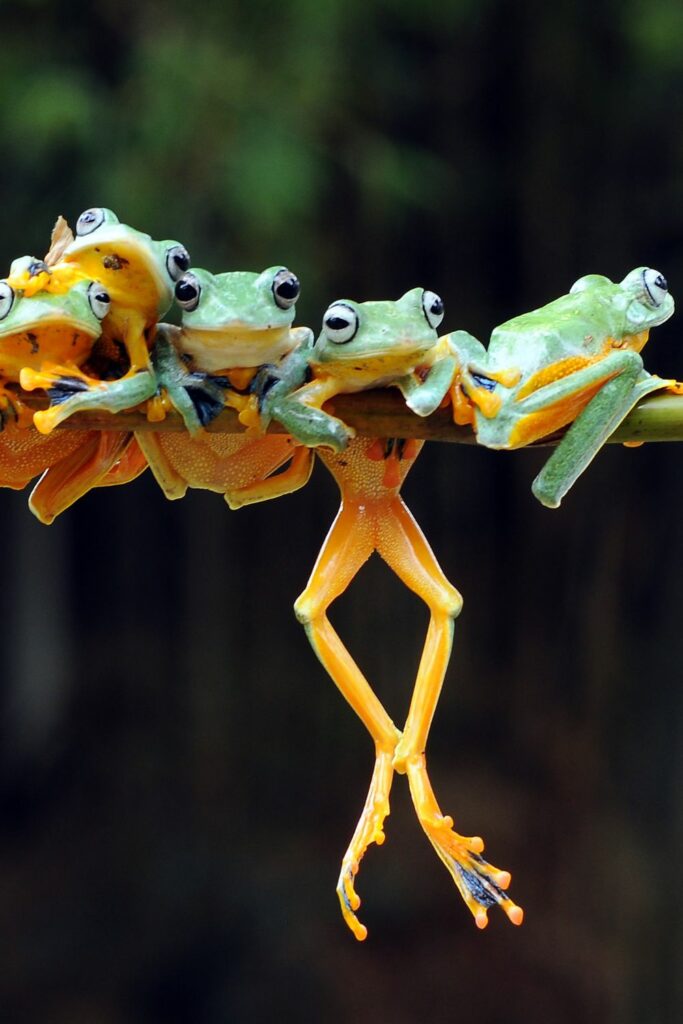
Causes and Impacts on Tree Frog Populations
Deforestation, urbanization, and land conversion for agriculture are primary causes of habitat loss for tree frogs. As vast stretches of forests are felled and wetlands drained, tree frogs lose not only their homes but also their sources of food and breeding grounds.
This habitat fragmentation often leads to isolated populations, making them more vulnerable to extinction due to limited genetic diversity and increased predation.
Pollution
Types of Pollutants Affecting Tree Frogs And Their Effects
Tree frogs are highly susceptible to pollution due to their semi-permeable skin. Pesticides, herbicides, and industrial chemicals that leach into water bodies can have devastating effects on frog populations.
These toxins can cause deformities, disrupt reproductive processes, or even lead to direct mortality. Moreover, light pollution in urban areas can disorient tree frogs, making them more vulnerable to predators.
Climate Change
Predicted Impacts on Tree Frog Habitats and Populations
As global temperatures rise and weather patterns become more erratic, tree frogs face new challenges. Altered rainfall patterns can affect their breeding cycles while rising temperatures might push certain species out of their comfort zones.
Moreover, climate change can also lead to the spread of diseases like chytridiomycosis, a fungal disease that has decimated amphibian populations worldwide.
Conservation Efforts
Efforts and Recommendations for Future Actions
Recognizing the threats faced by tree frogs, conservationists and researchers worldwide are working tirelessly to protect them. Efforts range from establishing protected habitats and national parks to breeding programs that aim to reintroduce populations into the wild.
Public awareness campaigns also play a crucial role, in educating people about the importance of tree frogs in our ecosystems.
Additionally, grassroots initiatives in regions with high tree frog diversity emphasize sustainable farming and forestry practices. These practices aim to balance economic growth with conservation.
On a global scale, international treaties and agreements, like the Convention on Biological Diversity, provide a framework for nations to collaborate on conservation efforts.
In the face of these challenges, the story of tree frog conservation is one of hope, resilience, and collaboration. It serves as a poignant reminder of our shared responsibility to safeguard our planet’s biodiversity and the delicate balance of life.
As we appreciate the beauty and wonder of tree frogs, let’s also pledge to be stewards of the environment, ensuring that their symphony continues to echo in the wild for generations to come.
Conclusion
Tree frogs, with their vibrant colors and melodic calls, are more than just a spectacle of nature. They play a pivotal role in our ecosystems and act as indicators of environmental health.
As they face challenges from habitat loss, pollution, and climate change, we must understand and value their significance.



